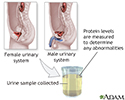Urine protein dipstick test
Urine protein; Albumin - urine; Urine albumin; Proteinuria; Albuminuria
The urine protein dipstick test measures the presence of all proteins, including albumin, in a urine sample.
Albumin and protein can also be measured using a blood test.
How the Test is Performed
After you provide a urine sample, it is tested. The health care provider uses a dipstick made with a color-sensitive pad. The color on the dipstick tells the provider the level of protein in your urine.
If needed, your provider may ask you to collect your urine at home over 24 hours. Your provider will tell you how to do this. Follow instructions exactly so that the results are accurate.
How to Prepare for the Test
Different medicines can change the result of this test. Before the test, tell your provider which medicines you are taking. DO NOT stop taking any medicine before talking to your provider.
The following may also interfere with test results:
- Dehydration
- Dye (contrast media) if you have a radiology scan within 3 days before the urine test
- Fluid from the vagina that gets into the urine
- Strenuous exercise
- Urinary tract infection
How the Test Will Feel
The test only involves normal urination. There is no discomfort.
Why the Test is Performed
This test is most often done when your provider suspects you have kidney disease. It may also be used as a screening test for kidney disease, for example in people with diabetes.
Although small amounts of protein are normally in urine, a routine dipstick test may not detect them. A urine microalbumin test can be performed to detect small amounts of albumin in the urine that may not be detected on dipstick testing. If the kidney is diseased, proteins may be detected on a dipstick test, even if blood protein levels are normal.
Normal Results
For a random urine sample, normal values are 0 to 14 mg/dL.
For a 24-hour urine collection, the normal value is less than 80 mg per 24 hours.
The examples above are common measurements for results of these tests. Normal value ranges may vary slightly among different laboratories. Some labs use different measurements or test different samples. Talk to your provider about the meaning of your specific test results.
What Abnormal Results Mean
Larger amounts of protein in the urine may be due to:
- Heart failure
- Kidney problems, such as kidney damage, diabetic kidney disease, and kidney cysts
- Loss of body fluids (dehydration)
- Multiple myeloma
- Problems during pregnancy, such as seizures due to eclampsia or high blood pressure caused by preeclampsia
- Urinary tract problems, such as a bladder tumor or infection
Risks
There are no risks with this test.
References
Krishnan A, Levin A. Laboratory assessment of kidney disease: glomerular filtration rate, urinalysis, and proteinuria. In: Yu ASL, Chertow GM, Luyckx VA, Marsden PA, Skorecki K, Taal MW, eds. Brenner and Rector's The Kidney. 11th ed. Philadelphia, PA: Elsevier; 2020:chap 23.
Lamb EJ, Jones GRD. Kidney function tests. In: Rifai N, ed. Tietz Textbook of Clinical Chemistry and Molecular Diagnostics. 7th ed. St Louis, MO: Elsevier; 2023:chap 34.
Review Date: 7/19/2021
Reviewed By: David C. Dugdale, III, MD, Professor of Medicine, Division of General Medicine, Department of Medicine, University of Washington School of Medicine. Also reviewed by David Zieve, MD, MHA, Medical Director, Brenda Conaway, Editorial Director, and the A.D.A.M. Editorial team.












